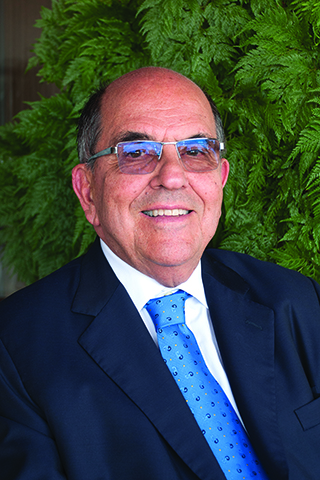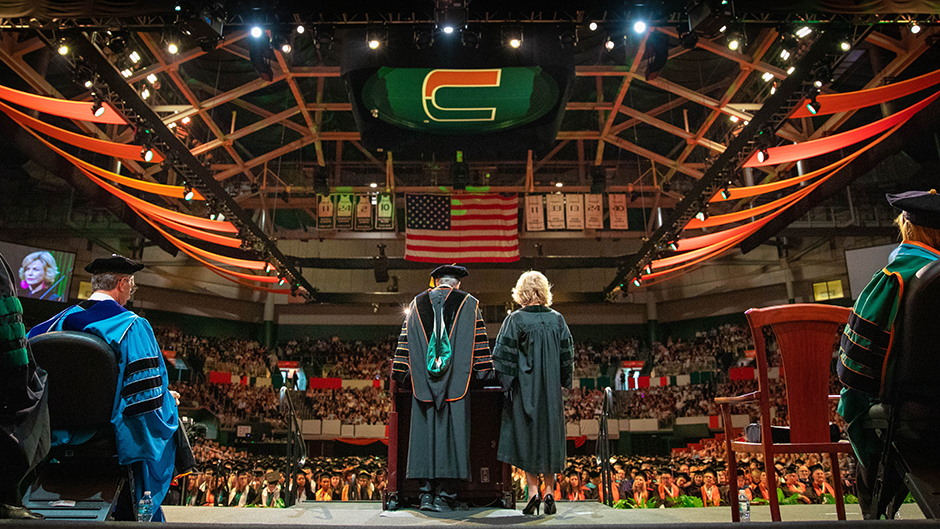Two extraordinary men who have spent their lives fighting malevolent forces that have destroyed so many other lives will be the speakers at the University of Miami’s fall commencement exercises on Thursday, Dec. 12, when more than 1,100 students cross the Watsco Center stage for their degrees.
Dr. Rodrigo Guerrero-Velasco, a Colombian epidemiologist, academician, and policymaker who pioneered a data-driven approach to combating urban violence, will address more than 550 students at the 10 a.m. undergraduate ceremony. Rabbi Arthur Schneier, a Holocaust survivor who founded the Appeal of Conscience Foundation to promote tolerance, religious freedom, and human rights around the world, will share his advice with more than 560 doctoral and master’s students at the 2 p.m. graduate degree ceremony.
For their extraordinary contributions to bettering our world, the speakers will receive honorary degrees from the University of Miami: Guerrero-Velasco, a Doctor of Science; and Rabbi Schneier, a Doctor of Humane Letters. Both their speeches and the commencement exercises can be viewed live online next week.

Born and raised in Cali, Colombia, Guerrero-Velasco was elected mayor of his hometown in 1992, a job that, as he has noted, was not an obvious fit for an epidemiologist. But the son of a physician who earned his medical degree at Cali’s Universidad del Valle, where he later served in many roles including president, was drawn to help people, and the citizens of Cali needed help.
At the time Guerrero-Velasco took office, homicide was the number one killer in Cali, where an average of five people were murdered in the coastal city every day—about the same number as New York City, which was five times larger.
Most observers assumed that the ruthless drug cartels were behind the violence, but Guerrero-Velasco, who earned his master’s degree in hygiene and his doctorate in public health from Harvard University, believed in data-driven evidence, not assumptions. So he assembled a task force of police, pathologists, statisticians, and fellow physicians who mapped and analyzed every homicide by time, neighborhood, and circumstance.
A surprising but clear pattern emerged: Most of the homicides occurred during weekends or after Friday paydays and involved young people, guns, and alcohol.
Armed with the knowledge that personal conflicts sparked the violence, Guerrero’s administration banned late-night alcohol sales, restricted weapons permits, and imposed targeted curfews. Almost immediately, homicides plummeted.
His approach of using data to identify and address risk factors, which he introduced to the Pan American Health Organization in Washington D.C., was adopted by other cities in Colombia and countries across the hemisphere. He employed the approach again, when in 2012, he was re-elected mayor of Cali during another rise in homicide rates. This time, the data showed most homicides occurred on weekdays and, involving high-powered firearms and criminal gangs, were premeditated.
Once again, Guerrero-Velasco devised targeted interventions for specific problems, including investing in social programs that by improving housing, health facilities, and education, helped reduce the inequalities that he knew were huge risk factors for disaffected youth.
“All the evidence shows societies that are poor and unequal are more prone to be violent than those that aren’t,” he said.
Cali’s murder rate dropped again, and in 2014 Guerrero-Velasco received the inaugural Roux Prize bestowed by the Institute for Health Metrics and Evaluation at Washington for his “bold action to improve population health through disease burden evidence.”
The author of numerous scientific publications and the founder of the journal Colombia Medica, he has received many other honors, including induction into the U.S.’s National Academy of Medicine.

Born in Vienna, Schneier was just 8 when, like all members of Austria’s Jewish community, he became a pariah. After Nazi tanks rolled into Austria in 1938, his Christian friends turned on him, and he was banned from his school and all his neighborhood haunts.
Months later, Schneier watched police and firemen stand by as rioters burned down his synagogue on Kristallnacht, the Night of Broken Glass. He and his widowed mother soon fled to Budapest, Hungary, where they lived in hiding through World War II, always in fear of capture and deportation to the death camps where his grandparents and 6 million other Jews perished.
During those dark years, Schneier made a promise to God that, more than seven decades later, he continues to fulfill. If he survived the atrocities he witnessed, he vowed to dedicate his life to promoting the peaceful coexistence of people of all faiths.
Known as a rabbi/diplomat, he has spent his life traveling the world, meeting with international political and religious leaders to ensure that religion is never used as a pretext for murder or oppression.
“God must have saved me for a reason,” Schneier has said.
After the war, Schneier emigrated to New York City, where he attended Yeshiva University. Ordained in 1955, he became senior rabbi at Park East Synagogue in 1962, turning the historic house of worship into a thriving center of religious educational life, inter-religious outreach, and social action, which blossomed with his concern over the growing persecution of Jews in the Soviet Union.
In January 1965, he organized human-rights activists, politicians, and interfaith clergy for an “Appeal of Conscience” rally, which was so successful he established the Appeal of Conscience Foundation (ACF) to harness the moral energy of a coalition of interfaith business and religious leaders.
Pushing for religious freedom and human rights, he led 85 ACF missions to the former Soviet Union, China, Europe, the Middle East, and Latin America. In 2008, he hosted Pope Benedict XVI, the first pope to visit a U.S. synagogue and the following year, he welcomed the Ecumenical Patriarch Bartholomew I, with whom he convened the first international conference of religious leaders from the Balkans, Caucuses, and Central Asia.
A former U.S. alternate representative to the United Nations, chair of the U.S. Commission for the Preservation of America’s Heritage Abroad, and ambassador to the U.N. Alliance of Civilizations, Schneier is a vice president of the World Jewish Congress and a member of the Council on Foreign Relations and the U.S. Holocaust Memorial Museum Committee on Conscience.
He has received many honors, including the Presidential Citizens Medal bestowed by President Bill Clinton for devoting his life “to overcoming forces of hatred and intolerance” and the Papal Knighthood of St. Sylvester, conferred by Pope Francis for “his unceasing work to promote peace and mutual understanding.”
Faculty who wish to participate in the academic procession should RSVP to commencement@miami.edu with their name and the ceremony they wish to attend. Both speeches and commencement ceremonies can be viewed live online by visiting UM’s commencement coverage at miami.edu on Thursday, Dec. 12, and viewing the Livestream.

